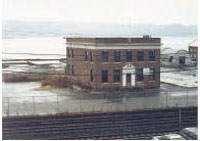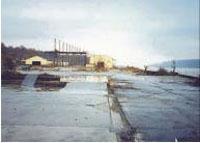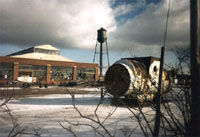



 |
 |
 |
 |
| Source: http://www.epa.gov/swerosps/bf/about.htm | Source: http://www.dec.state.ny.us/website/der/bcp/ |
What is a brownfield?
A brownfield is an abandoned, idled, or underused industrial or commercial facility in which redevelopment is burdened by real or potential environmental contamination.* Typical businesses that leave behind such contaminated sites include:
The presence of underused or vacant industrial properties in inner cities is often caused by industries moving to suburban or rural sites, where land and taxes are less expensive. The owners of the remaining vacant facilities have trouble selling their sites, as possible buyers are wary of potential liability for cleanup costs and environmental contamination. As a result, many sites end up being abandoned, decreasing the tax base of the area and becoming sources of blight in the community.
What are the potential benefits to redeveloping brownfields?
The redevelopment of brownfields can provide many benefits to a community, including an increased tax base, the creation of new jobs, the utilization of existing infrastructure, and the removal of blight. The removal of contaminants in the area also helps to protect human health and the environment.
The Liability Issue
One of the main issues involving brownfield redevelopment is the concern over legal liability. The uncertainty of rehabilitation costs for contaminated sites can frighten away many potential developers and investors. In an effort to combat such liability risks, laws at the federal and state levels have been implemented to minimize risk.
Two of the most influential federal laws affecting the redevelopment of brownfields are the Comprehensive Environmental Response, Compensation, and Liability Act (CERCLA) and the Resource Conservation and Recovery Act (RCRA).
Comprehensive Environmental Response, Compensation, and Liability Act
CERCLA, also known as “Superfund,” establishes a liability system in which responsible parties must pay for the cleanup of contaminated sites. It also establishes a trust fund used to pay for the remediation of such contaminated sites.
CERCLA was enacted by Congress in 1980 and gives authority to the Environmental Protection Agency (EPA) to initiate investigations and cleanup and to take enforcement action against parties responsible for the leaking of hazardous wastes, pollutants, or contaminants into the environment. However, CERCLA can often make redevelopment of a site more difficult by holding a variety of people responsible for cleanup expenses. Such potentially liable parties include present owners and operators, past owners and operators, generators of the hazardous waste, and transporters of the waste who moved it from one site to another. Under CERCLA, liability is also “strict” (owners, operators, generators, and transporters can all be held liable for a contaminated plot, regardless of fault); “joint and several” (one potentially responsible party can be held responsible for all cleanup costs, even though other parties may have been involved in the contaminiation); and “retroactive” (liability can be assessed to contaminants released prior to the enactment of CERCLA, and buyers can be held liable for the cleanup costs of a site even if they were unaware of its contamination at the time of sale).
CERCLA also calls for the creation of a list of the most dangerous sites that have either released or have the potential to release hazardous contaminants. Known as the National Priorities List (NPL), these sites can potentially receive CERCLA aid. There are currently about 1,200 NPL sites across the U.S.
Resource Conservation and Recovery Act
The Resource Conservation and Recovery Act (RCRA) was enacted by Congress in 1976 and is a “cradle to the grave” program, managing the generation, transportation, storage, treatment, and disposal of hazardous waste. It affects the redevelopment of brownfields in three ways: it deals with petroleum based products, including underground storage tanks (USTs); it regulates cleanup activities at active hazardous waste treatment, storage, and disposal facilities (TSDFs); and it includes requirements for substances that contain any of over 200 hazardous constituents, thereby possibly further restricting the handling and disposal of wastes produced during the remediation of a site.
Unlike CERCLA, RCRA differs has the Corrective Action Program that deals with sites that have viable operators and on-going operations. The CERCLA/Superfund program mainly deals with sites that have been abandoned or vacated and that are releasing or potentially leaking contaminants into the surrounding environment. CERCLA typically deals with sites in which owners or operators cannot be found and that might require financial aid for their cleanup from the Superfund.
State Programs
States have also enacted laws to alleviate the risks of liability for potential developers and investors of brownfield sites. Many state programs include Superfund laws and Voluntary Cleanup Programs (VCPs). State Superfund programs are present in more than 45 states and are modeled for the most part after CERCLA. Voluntary Cleanup Programs are often initiated for lower priority or less dangerous sites and are intended to promote private-sector involvement in the remediation process. They encourage such involvement by offering financial incentives, such as tax credits; alternative cleanup standards that offer more flexibility than federal and state Superfund laws; streamlined oversight procedures, in which developers don't have to go through lengthy administrative procedures; and liability incentives or assurances from the state.
In 1995 the State of Michigan created a VCP as part of the Michigan Environmental Response Act (MERA). The Michigan VCP is made up of a Site Reclamation Fund and a Site Assessment Fund and is administered by the Michigan Department of Environmental Quality (DEQ). It includes a variety of liability assurances and incentives, such as covenants not to sue, third party liability relief to lenders and innocent new land owners, and in some cases even liability exemptions (sometimes given to purchasers of contaminated land if they submit a baseline environmental assessment within a certain amount of time). [1] Financial incentives are also an important part of Michigan's VCPs. In 1989 a $425 million bond issue made grants of up to $1 million available to governmental units for assessment and remediation of sites. While the funds from the 1989 bond issue are dwindling, the 1998 “Clean Michigan Initiative” authorized a second bond issue for $675 million. Other financial incentives include Tax Increment Financing (TIFs) in “brownfield zones,” tax credits, and a Revitalization Revolving Loan Fund (in which loan payments that are received are then loaned out again for new projects). Business incentives for brownfields redevelopment also exist in the form of Brownfield Redevelopment Authorities (BRAs), which are created in municipalities with the purpose of assisting in the implementation of plans to create Brownfield Redevelopment Zones and to cleanup contaminated properties.
Sources of Funding**
Federal, state, and local sources of funding for brownfield redevelopment are varied, though some of the main sources include Brownfields Economic Development Initiative grants (BEDIs), Community Development Block Grants (CDBGs), Section 108 Loan Guarantees, Empowerment Zones and Enterprise Communities, the Small Business Association's (SBA) 504 loan program, historic rehabilitation tax credits, and the Economic Development Administration's (EDA) Title IX program. [2]
Brownfields Economic Development Initiative Grants, administered by the Department of Housing and Urban Development (HUD), were first created in 1999 with the appropriation of $25 million for brownfields redevelopment. BEDI grants are to be used in disenfranchised areas and can only be employed to enhance those projects that are already receiving aid and financing from Section 108 loan funds (thus local governments and their agencies are the only parties eligible for BEDI grants).
For more info: http://www.hud.gov/offices/cpd/economicdevelopment/programs/bedi/index.cfm
Community Development Block Grants (CDBGs), also administered by HUD, are designed to promote neighborhood revitalization and the expansion of affordable housing and economic opportunities, [3] though an eligible application of CDBGs also includes the rehabilitation and redevelopment of brownfields.
For more info: http://www.huduser.org/publications/econdev/redevelo.html ,
http://www.huduser.org/publications/doc/cdbgreport.doc
Section 108 Loan Guarantees, administered by HUD, are loans that are offered to communities that receive CDBG funds. As with CDBG grants, redevelopment projects must focus on the development of affordable housing and economic opportunities, eliminate or prevent slums and blights, or meet urgent community needs. Section 108 loans can supply communities with up to five times their yearly CDBG grant amount, thus providing communities with the funding to finance redevelopment projects of a larger scale.
For more info: http://www.hud.gov/offices/cpd/communitydevelopment/programs/108/index.cfm
Renewal Communities, Empowerment Zones, and Enterprise Communities (RC/EZ/EC) are administered by the federal government (HUD) and are intended to create and retain jobs through the use of tax and financial incentives. RC/EZ/EC designations are made to assist areas undergoing a lack of economic growth and are most often found in communities that have high levels of poverty, signs of blight, population loss, and a lack of economic development activity. [4] RC/EZ/EC zones offer five different types of tax incentives to companies willing to develop sites within the zone's boundaries. These include tax credits, deductions, deferrals, tax abatements, and tax exemptions.
For more info: http://www.hud.gov/offices/cpd/economicdevelopment/programs/rc/index.cfm
Other sources of funding for the redevelopment of brownfield sites include the Historic Preservation Tax Incentive Program, which offers a tax credit to be taken against the investor's total income when old buildings/structures are rehabilitated and put back into productive use; Economic Development Administration (EDA) Public Works Grants; and Economic Development Adjustment Assistance (formerly referred to as Title IX).
EPA Brownfields Program
The EPA Brownfields Program supports locally based initiatives as well as public-private partnerships. The program consists of three main areas of support: technical and financial support for assessment and cleanup (including job training grants); partnerships to protect human health and the environment (including the Brownfields Federal Partnership, which is a forum for federal government agencies to discuss issues dealing with brownfield rehabilitation and form cooperative alliances); and initiatives to encourage private sector involvement (such as federal tax incentives like the 1997 Taxpayer Relief Act, which allows for expenses due to cleanup costs to be fully deductible in the year they're experienced, rather than being capitalized). [5]
Conclusion
For the most effective and efficient remediation of brownfields, efforts between federal, state, local, and private organizations must be coordinated. The role of the local city government and surrounding community is especially important, since they can often best prioritize sites most in need of rehabilitation, encourage private sector participation, and serve as an organizer of other local actors. Local financing tools can include loans, loan guarantees, revolving loan funds, bond financing, tax abatements/credits, TIFs, grants, and the provision or improvement of public infrastructure.
Links for more info:
Department of Housing and Urban Development:
http://www.hud.gov/offices/cpd/economicdevelopment/programs/bedi/bedilinks.cfm
Environmental Protection Agency:
http://www.epa.gov/brownfields/
http://www.epa.gov/swerosps/bf/index.html
http://www.brownfieldsource.org/
http://www.brownfields.com/
Northeast Midwest Institute
http://www.nemw.org/brownfields.htm
National Center for Neighborhood and Brownfields Redevelopment ( Rutgers Univ.):
http://policy.rutgers.edu:16080/brownfields/
Citizens Research Council of Michigan (a great site for concerning brownfield
redevelopment in Michigan):
http://www.crcmich.org/EDSurvey/financg-taxauthorities/ba.html
Michigan Department of Environmental Quality:
http://www.michigan.gov/deq/0,1607,7-135-3311_4110---,00.html
Great Lakes Sustainable Land Use:
http://www.glc.org/bridges/brownfields.html
For information concerning the redevelopment of specific brownfield sites in Michigan:
Consumers Energy in Jackson County, MI:
http://www.epa.gov/swerosps/bf/pdf/ss_jacks.pdf
MacKenzie's Bakery in Kalamazoo, MI:
http://www.epa.gov/swerosps/bf/html-doc/ss_klam2.htm
*as defined by the United States Environmental Protection Agency
**Definitions of funding sources provided by:
International Economic Development Council. Brownfields Redevelopment Manual.
Available online: http://www.iedconline.org/brownfields_redevelopment_manual.html
[1] International
Economic Development Council. Brownfield Redevelopment , p. 64.
[2] Ibid., 100.
[3] Ibid.,
101.
[4] Ibid.,
104.
[5] http://www.epa.gov/swerosps/fb/brtaxinc.htm.